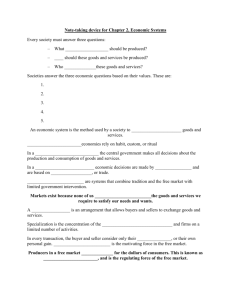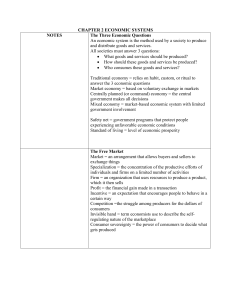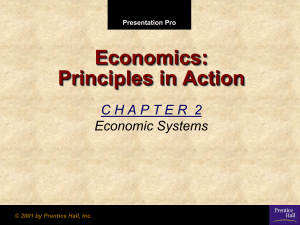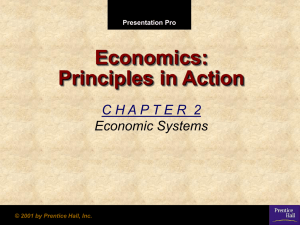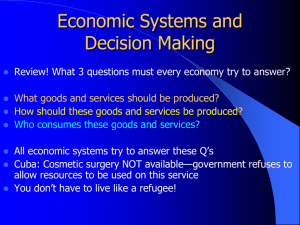Ch. 2 Cornell Notes
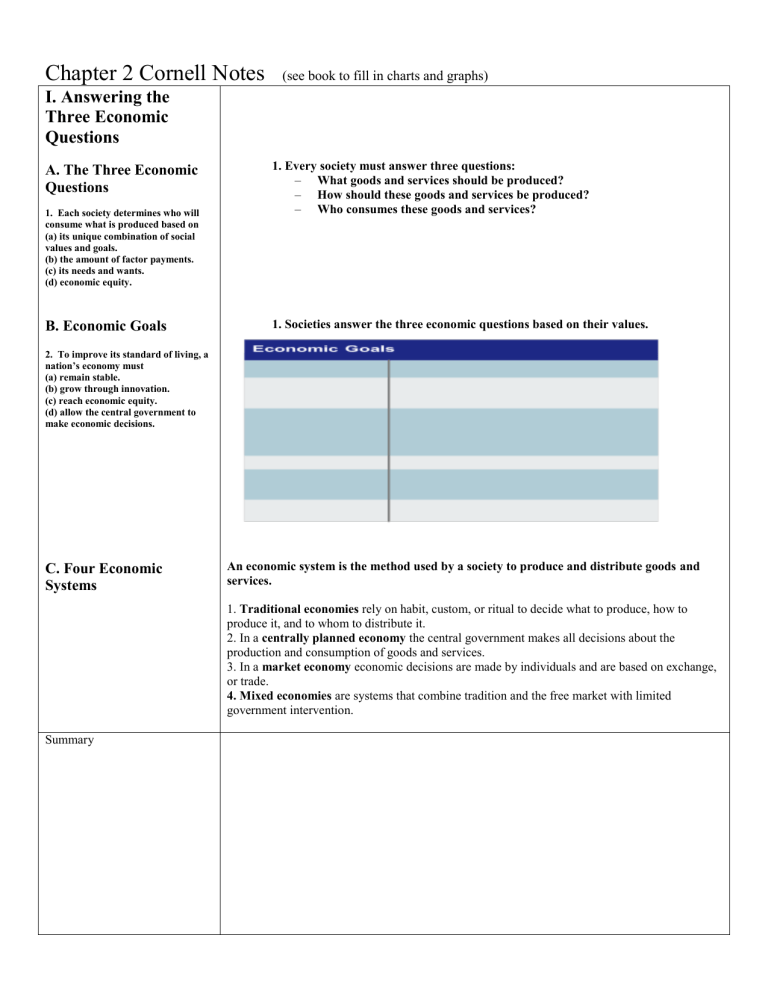
Summary
Chapter 2 Cornell Notes
(see book to fill in charts and graphs)
I. Answering the
Three Economic
Questions
A. The Three Economic
Questions
1. Each society determines who will consume what is produced based on
(a) its unique combination of social values and goals.
(b) the amount of factor payments.
(c) its needs and wants.
(d) economic equity.
B. Economic Goals
2. To improve its standard of living, a nation’s economy must
(a) remain stable.
(b) grow through innovation.
(c) reach economic equity.
(d) allow the central government to make economic decisions.
C. Four Economic
Systems
1. Every society must answer three questions:
– What goods and services should be produced?
– How should these goods and services be produced?
– Who consumes these goods and services?
1. Societies answer the three economic questions based on their values.
An economic system is the method used by a society to produce and distribute goods and services.
1.
Traditional economies rely on habit, custom, or ritual to decide what to produce, how to produce it, and to whom to distribute it.
2. In a centrally planned economy the central government makes all decisions about the production and consumption of goods and services.
3. In a market economy economic decisions are made by individuals and are based on exchange, or trade.
4. Mixed economies are systems that combine tradition and the free market with limited government intervention.
II. The Free Market
A. Why Do Markets
Exist?
3 . Why do people need to buy and sell goods or services?
(a) People need to buy and sell goods to make a profit.
(b) People buy and sell to maintain a competitive society.
(c) No one is self-sufficient.
(d) People need to provide the market with goods and services.
B. The Free Market
Economy
C. The Market’s Self-
Regulating Nature
4. What factors create the phenomenon of the “invisible hand”?
(a) incentives and efficiency
(b) specialization and efficiency
(c) competition between firms
(d) competition and self-interest
Advantages of the Free Market
Summary
Markets exist because none of us produces all the goods and services we require to satisfy our needs and wants.
1. A market is an arrangement that allows buyers and sellers to exchange goods and services.
2. Specialization is the concentration of the productive efforts of individuals and firms on a limited number of activities.
1. In a free market economy, households and business firms use markets to exchange money and products. Households own the factors of production and consume goods and services.
1. In every transaction, the buyer and seller consider only their self-interest, or their own personal gain. Self-interest is the motivating force in the free market.
2. Producers in a free market struggle for the dollars of consumers. This is known as competition, and is the regulating force of the free market.
3. The interaction of buyers and sellers, motivated by self-interest and regulated by competition, all happens without a central plan. This phenomenon is called “the invisible hand of the marketplace.”
1. Economic Efficiency
As a self-regulating system, a free market economy is efficient.
2. Economic Growth
Because competition encourages innovation, free markets encourage growth.
3. Economic Freedom
Free market economies have the highest degree of economic freedom of any economic system.
4. Additional Goals
Free markets offer a wider variety of goods and services than any other economic system.
III. Centrally Planned
Economies
Union
A. Organization of
Centrally Planned
Economies
5. In a socialist country,
(a) central planning is unnecessary.
(b) the government often owns major industries, such as utilities.
(c) an authoritarian government controls the economy.
(d) economic equality is not important.
6. Which of the following is an advantage of a centrally planned economy?
(a) the system’s bureaucracies are small and flexible
(b) the system can work quickly to accomplish specific goals
(c) innovation is well rewarded
(d) consumers’ needs are well met
B. The Former Soviet
C. Problems of a
Centrally Planned
Economy
Summary
In a centrally planned economy, the government owns both land and capital. The government decides what to produce, how much to produce, and how much to charge.
1. Socialism is a social and political philosophy based on the belief that democratic means should be used to distribute wealth evenly throughout a society.
2. Communism is a political system characterized by a centrally planned economy with all economic and political power resting in the hands of the government.
• Soviet Agriculture
– In the Soviet Union, the government created large state-owned farms and collectives for most of the country’s agricultural production.
• Soviet Industry
– Soviet planners favored heavy-industry production (such as steel and machinery), over the production of consumer goods.
•
Soviet Consumers
– Consumer goods in the Soviet Union were scarce and usually of poor quality.
Centrally planned economies face problems of poor-quality goods, shortages, and diminishing production.
IV. Modern
Economies
A. The Rise of Mixed
Economies
B. Government’s Role in a Mixed Economy
1. The United States economy is a mixed economy
(a) based on the principle of a traditional economy, but allows some government intervention.
(b) based on the principles of a centrally planned economy, with limited government intervention.
(c) based on the principles of the free market, and allows no government intervention.
(d) based on the principles of the free market, but allows some government intervention.
C. Comparing Mixed
Economies
2. Government intervention in a modern economy is useful because
(a) the needs and wants of modern society are always met by the marketplace.
(b)the marketplace has many incentives to create public goods such as parks and libraries.
(c)governments are able to provide some goods and services that the marketplace has no incentive to produce.
(d) the marketplace provides all of its own laws.
Summary
Market economies, with all their advantages, have certain drawbacks.
Limits of Laissez Faire
Laissez faire is the doctrine that government generally should not interfere in the marketplace.
Governments create laws protecting property rights and enforcing contracts. They also encourage innovation through patent laws.
1. In a mixed economy,
• The government purchases land, labor, and capital from households in the factor market, and
• Purchases goods and services in the product market.
1. An economic system that permits the conduct of business with minimal government intervention is called free enterprise. The degree of government involvement in the economy varies among nations.
